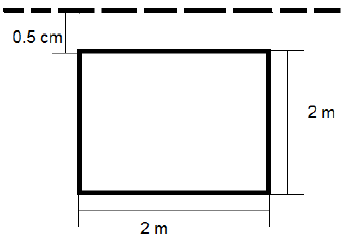This quiz contains multiple-choice problems on hydrostatic force on plane area, fluid pressure distribution, horizontal and inclined planes in liquid, total pressure and vertical plane surface.
Does total pressure take into account the force exerted by the fluid when it is in dynamic motion?
Yes
No
Depends on conditions
Depends on type of motion
Which of the following principles is used to calculate the pressure centre?
Principle of momentum
Principle of energy conservation
Principle of momentum balancing
None of the above
A pipeline of 6 m diameter contains a gate valve, and the pressure at the pipe’s centre is 25 N/cm^2. If the pipe is filled with a liquid of specific gravity 0.8, find the force exerted by the oil upon the gate.
7.06 MN
14.12 MN
3.53 MN
28.24 MN
Determine the centre of pressure on an isosceles triangular plate of base 6m and altitude 6m when immersed vertically in oil of specific gravity 0.75. The base of the plate coincides with the free surface of the oil.
6 m
3 m
9 m
12 m
A tank contains water up to 0.5 m vertically from the base. An immiscible liquid of specific gravity 0.75 is filled on top of water up to a height of 1.5 m. Calculate the total pressure on the side of the tank.
17780.61 N/m^2
35561.22 N/m^2
71122.44 N/m^2
8890.31 N/m^2
A square lamina (each side equal to 2m) is submerged vertically in water such that the upper edge of the lamina is at a depth of 0.5 m from the free surface. What will be the total water pressure (in kN) on the lamina?
19.62
39.24
58.86
78.48
Can the centre of pressure for a vertically submerged surface be ever above its centre of gravity?
Yes
No
It can be in cases where surface height is very large
None of the above
An equal volume of two liquids with densities ρ{1} and ρ{2} are poured into two identical cuboidal beakers. The hydrostatic forces on the respective vertical face of the beakers are F{1} and F{2}, respectively. If ρ{1} > ρ{2}, what will be the correct relation between F{1} and F{2}?
F{1} > F{2}
F{1} ≥ F{2}
F{1} < F{2}
F{1} ≤ F{2}
By what factor will the hydrostatic force on one of the vertical sides of a beaker decrease if the height of the liquid column is halved?
1 ⁄ 2
1 ⁄ 3
1 ⁄ 4
2 ⁄ 3
Which of the following is the correct relation between centroid (G) and the centre of pressure (P) of a plane submerged in a liquid?
G is always below P
P is always below G
G is either at P or below it.
P is either at G or below it.
A beaker contains water up to a height of h. What will be the location of the centre of pressure?
h/3 from the surface
h/2 from the surface
2h/3 from the surface
h/6 from the surface
A cubic tank is completely filled with water. What will be the ratio of the hydrostatic force exerted on the base and on any one vertical side?
1:1
2:1
1:2
3:2
A rectangular lamina of width b and depth d is submerged vertically in water, such that the upper edge of the lamina is at a depth h from the free surface. What will be the expression for the depth of the centroid (G)?
h
h + d
h + d ⁄ 2
h - d / 2
A cuboidal beaker is half-filled with water. What per cent will the hydrostatic force on one of its vertical sides increase if it is filled with water?
100
200
300
400
A rectangular lamina of width b and depth d is submerged vertically in water, such that the upper edge of the lamina is at a depth h from the free surface. What will be the expression for the depth of the centre of pressure?
h+ ((d/3) * (2*h + d)/(3*h+2*d))
h+ ((d/6) * (3*h+2*d)/(h + 2*d))
h+ ((d/3) * (3*h+2*d)/(2*h + d))
h+ ((d/3) * (3*h + 2*d)/(h + d))